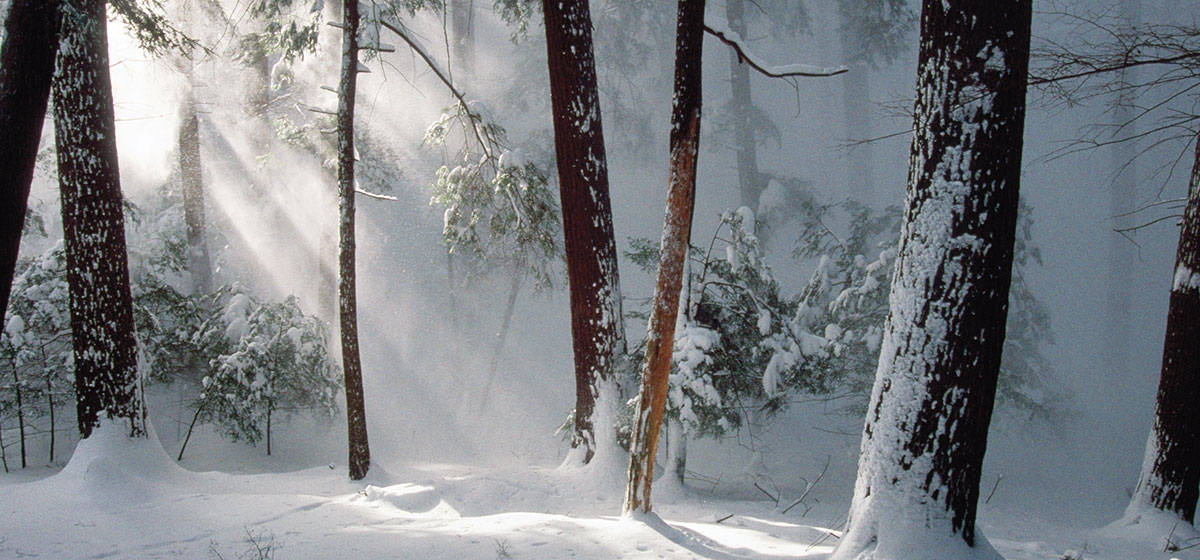Protecting Cook Forest

Anthony Cook has a name that carries responsbility. He is the fifth generation of the Cook family—and the fourth named Anthony—involved in the creation and preservation of Cook Forest State Park.
The story began in 1826, when John Cook, Anthony’s great-great-grandfather, ventured to the rugged hills of western Pennsylvania on a surveying expedition for the governor. Cook went in search of canal routes along the Clarion River and saw the great beauty and value of the land. He returned and purchased 765 acres, settling with his wife and 10 children and starting a lumber business. Cook and his sons built a sawmill, a series of dams and flatboats. They began sending lumber and logs downstream to the Allegheny River to meet the building demands of burgeoning Pittsburgh.
Business and the family’s land holdings grew. They knew the value of their trees, but they also recognized the forest’s beauty. For his home, Cook’s son Anthony selected an area surrounded by the biggest and best trees. He saved this land and more, ultimately setting aside 7,200 acres of forest for protection. In turn, his son, Anthony Wayne Cook, gathered a group of Pittsburgh citizens and others who embarked on a 17-year campaign to save the forest as a public park. And in 1927, Anthony Wayne Cook deeded the land to Pennsylvania, creating Cook Forest, the first state park in Pennsylvania.
“I had the good fortune of having my childhood home in Cook Forest,” said Anthony Cook. A naturalist and photographer, Cook has documented conservation projects around the globe. He also documented the forest closest to his heart in his 1997 book, “The Cook Forest, An Island in Time.” Cook’s love for the park’s natural majesty is almost matched these days by his concern for the long-term survival of the old-growth forest.
The most immediate threat is the white-tailed deer, which are devastating the young vegetation and eradicating the ancient rhododendrons. State park officials have fenced a small experimental exclosure to keep the deer out, allowing successful regeneration of native species. However, what concerns Cook most is a creature much smaller than a deer. It’s an aphid, known as hemlock woolly adelgid. The insect threatens the most magnificent part of the national landmark—the trees.
Cook describes the hemlock woolly adelgid, as “a sap-sucking little fellow who can kill a tree in three to four years.” In 2002, the aphid invaded the Great Smoky Mountains National Park, destroying over 50 percent of its vast Eastern hemlock population. Since 1989, it has devastated over 90 percent of the hemlocks once found in Shenandoah National Park.
“Cook Forest is considered to be the best quality old-growth forest of any type in the northeastern U.S.,” said Lee Frelich, who teaches forestry at the University of Minnesota. “And it has the most magnificent stand of Eastern hemlock in the world that has not been infested with the hemlock woolly adelgid.”
Bob Leverett, co-founder of the Eastern Native Tree Society, agreed. “Cook Forest’s Eastern hemlock stands are without equal. They possess that timeless look that only ancient forests have, and they tether us to a past when natural forces shaped the wooded landscape. It would be a loss of monumental proportions, were we to allow the magic hemlock stands of Cook Forest to succumb to an alien insect.”
Cook hopes the state will make every effort to kill the insect if and when it invades Cook Forest. This involves systemically injecting insecticides into the larger hemlocks and spraying the smaller trees. In the Great Smoky Mountains National Park, an aphid-eating beetle has been introduced to fight the infestation. In the past, however, such action has not been taken until large infestations were present. And that has been too late.
Cook worries that in the current economy, the state will not have the resources to protect Cook Forest’s old-growth hemlocks. And with hemlocks representing about half the forest’s trees, saving them will require public and private capital.
The invading aphid has been spotted in contiguous counties, and the state has a plan in place. “When it gets here, we will be as prepared as we can be,” said Dale J. Luthringer, who has worked at Cook Forest for 14 years, currently as environmental education specialist. “We’re looking at a soil injection, the least invasive procedure, avoiding wounds to the tree. It’s expensive to treat no matter what you do, and the state’s limited funding won’t be enough, so we’ll be looking for donations.”
For Cook, it’s a question of priorities. “I’d like to think we will have the resolve to step forward and preserve this most precious forest. I can’t imagine how terrible it would be to have the hillsides stand bare with the death of its giant hemlocks. The Eastern hemlock is the redwood of the East, providing shelter, food and shade for other plants and wildlife. The Eastern hemlock was so revered by our ancestors that it was designated the state tree of Pennsylvania.”
Human intervention doesn’t come easily to Cook. “I love a forest that is untouched. A fallen tree returns nutrients to the soil and creates natural fences where new growth can take root, where predatory animals can’t get to it. Leave things in their natural state, and our great-great-grandchildren will still have Cook Forest in 250 years. But when you have an invasion of an exotic insect, you have to step forward and stop that.”
The State of Pennsylvania has formed the PA Parks and Forestry Foundation, which accepts donations to help Cook Forest combat the hemlock woolly adelgid. Donations may be mailed to: Cook Forest State Park, Hemlock Woolly Adelgid Fund, 113 River Road, Cooksburg, PA 16217.

